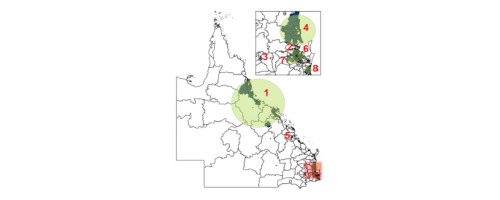当前位置:
X-MOL 学术
›
Int. J. Parasitol.
›
论文详情
Our official English website, www.x-mol.net, welcomes your feedback! (Note: you will need to create a separate account there.)
Clustering of cryptosporidiosis in Queensland, Australia, is not defined temporally or by spatial diversity.
International Journal for Parasitology ( IF 4 ) Pub Date : 2020-02-29 , DOI: 10.1016/j.ijpara.2019.11.010 Kathryn P Greenwood 1 , Simon A Reid 1
International Journal for Parasitology ( IF 4 ) Pub Date : 2020-02-29 , DOI: 10.1016/j.ijpara.2019.11.010 Kathryn P Greenwood 1 , Simon A Reid 1
Affiliation

|
Cryptosporidiosis, caused by infection with Cryptosporidium spp., is a globally distributed disease that manifests as diarrhoea for which there is no effective treatment. The protozoan parasite Cryptosporidium is difficult to detect and control, and can lead to severe disease in young children and the immunocompromised. Individual outbreaks across Australia have predominately been reported in urban areas associated with recreational water, but investigation of spatiotemporal distribution of disease is limited. This study evaluated the spatial and temporal patterns of clusters of notified cases of cryptosporidiosis in the north-eastern Australian state of Queensland, which has the highest average notified cases nationally. A spatiotemporal analysis in SaTScan of 12,263 notified cases from mid 2001 to mid 2015 identified 79 statistically significant disease clusters (P < 0.05). Analyses of annual incidence and disease cluster formation across the state illustrated the substantial randomness of clustering with no clear geographic distribution. Outbreaks were observed temporally across all latitudes and in rural and urban settings, with the majority of clusters centred in major and regional cities. Whilst clusters appeared in areas of high incidence, high incidence itself was not a predictor of clusters. Clusters generally formed during the hottest months between January and April, and cases were primarily children aged 0 to <5 years. Spatiotemporal analysis at a statewide level is an important indicator of regional disease patterns and can act as a trigger for targeted epidemiological investigation.
中文翻译:

在澳大利亚昆士兰州,隐孢子虫病的聚类并未在时间上或空间上得到定义。
由隐孢子虫感染引起的隐孢子虫病是一种全球性疾病,表现为腹泻,目前尚无有效的治疗方法。原生动物的寄生虫隐孢子虫很难检测和控制,并可能导致严重的幼儿疾病和免疫功能低下。在澳大利亚,与娱乐用水有关的城市地区主要爆发暴发疫情,但对疾病时空分布的调查有限。这项研究评估了澳大利亚东北昆士兰州隐孢子虫病通报病例群的时空分布,该病例在全国平均通报病例中最高。SaTScan中的时空分析为12 2001年中至2015年中的263例通报病例确定了79个具有统计学意义的疾病群(P <0.05)。整个州的年发病率和疾病簇形成的分析表明,簇的随机性很大,没有明确的地理分布。在所有纬度以及农村和城市环境中,在时间上都观察到暴发,大多数群集中在主要和区域城市。尽管集群出现在高发地区,但高发本身并不是集群的预测指标。通常在1月至4月的最热月份形成簇,病例主要是0至<5岁的儿童。在全州范围内进行时空分析是区域疾病模式的重要指标,并且可以触发针对性的流行病学调查。
更新日期:2020-03-02
中文翻译:

在澳大利亚昆士兰州,隐孢子虫病的聚类并未在时间上或空间上得到定义。
由隐孢子虫感染引起的隐孢子虫病是一种全球性疾病,表现为腹泻,目前尚无有效的治疗方法。原生动物的寄生虫隐孢子虫很难检测和控制,并可能导致严重的幼儿疾病和免疫功能低下。在澳大利亚,与娱乐用水有关的城市地区主要爆发暴发疫情,但对疾病时空分布的调查有限。这项研究评估了澳大利亚东北昆士兰州隐孢子虫病通报病例群的时空分布,该病例在全国平均通报病例中最高。SaTScan中的时空分析为12 2001年中至2015年中的263例通报病例确定了79个具有统计学意义的疾病群(P <0.05)。整个州的年发病率和疾病簇形成的分析表明,簇的随机性很大,没有明确的地理分布。在所有纬度以及农村和城市环境中,在时间上都观察到暴发,大多数群集中在主要和区域城市。尽管集群出现在高发地区,但高发本身并不是集群的预测指标。通常在1月至4月的最热月份形成簇,病例主要是0至<5岁的儿童。在全州范围内进行时空分析是区域疾病模式的重要指标,并且可以触发针对性的流行病学调查。



























 京公网安备 11010802027423号
京公网安备 11010802027423号